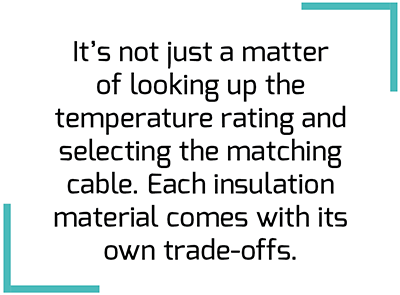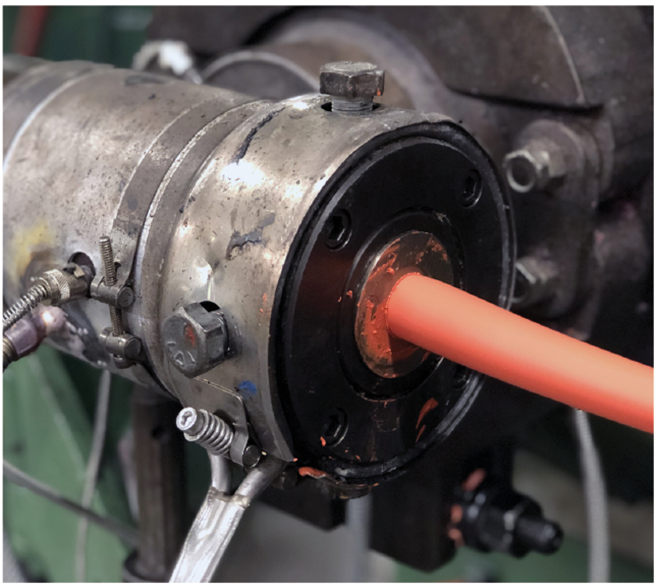Why Champlain Cable backs irradiation cross-linking for high-voltage EV cable insulation
When you think of what makes up an EV, cables and wires probably aren’t the first components that come to mind. But these conduits comprise the electrical cardiovascular system that makes a vehicle function – from the battery to the motor and all the stops in between.
Both wires (single conductors) and cables (bundles of conductors) must be chosen with care for any electrical system – EVs especially. How much current must the wires support? Is it constant or intermittent? What type of insulation is needed? What’s the temperature around the wires, and is there any air flow? How many cables are running together? Are they creating electromagnetic interference that could disrupt sensitive electronics? How long should the cables last? The list goes on.
The answers to these questions will determine the type of cable needed for an EV application. Even in this context, the solution may vary: a consumer EV will have different requirements than an electric bus will, for instance. Either way, in the automotive realm, weight is critical. After an EV’s powertrain and chassis, cable and wire harnesses are among the heaviest components. If you can reduce the size and weight of your wire and cable harnesses, you can improve the range of your vehicle.


Cable considerations
Richard Antic of cable manufacturer Champlain Cable points out one of the primary considerations for an EV cable system: the heat it must withstand over the expected life of the electrical system.
“OEMs are balancing the performance of the cable with the heat that’s going to be generated over the life of the vehicle,” Antic told Charged. “And there are different factors to consider across different EV/HEV platforms.”
Exposure to heat weakens cables over time, so the usable life of a cable system is determined, in part, by the cumulative heat exposure to which the cables are exposed. As Antic puts it, the higher the temperature, the faster usable life is withdrawn from the cable. You can think of cable life like a savings account. Say a brand-new cable starts with $1,000 in the bank. Low thermal exposure withdraws money slowly, perhaps pennies at a time, whereas higher thermal exposure withdraws money dollars or tens of dollars at a time. Eventually, the cable has lost too much of its original properties, and is more prone to breakdown.
Different cables have different temperature ratings depending on the insulation material used. Cables with polyvinylchloride (PVC) insulation are typically rated for 90° to 105° C. Insulation made from elastomers like thermoplastic polyurethane (TPU) and many cross-linked polyethylenes (XLPE) are rated up to 125° C. Irradiation XLPE is rated up to 150° C. At the top of the charts, both silicone and cross-linked fluoroelastomers (XLFEs) are rated at up to 200°. Heat exposure that exceeds a cable’s rated temperatures will start making larger withdrawals from its “savings account.”


But it’s not just a matter of looking up the temperature rating and selecting the matching cable. Each insulation material comes with its own trade-offs. For example, although it can withstand extremely high temperatures, XLFE is often too stiff to use in EV/HEV battery cables. Conversely, silicone, while very flexible, may not have the thin diameter, mechanical strength or battery acid resistance required; or perhaps outgassing is a concern. TPU has great water resistance, but its thermal life, dielectric and cutting/stripping properties may not make it the optimal choice. PVC on the other hand, is inexpensive and flexible, but its thermal ceiling is generally too low for many EV/HEV applications.
Choosing a cable
Cable sizing is determined by a number of factors, including current draw and temperature rise created by the current as it runs through the conductor; cable temperature rating; and as other thermal factors such as air flow, other sources of heat, etc.
“Every customer, when they’re designing their system, eventually understands what their power requirements are going to be,” explained Antic. “Let’s say it’s a city bus. You’re designing around a worst-case scenario. So you calculate the power based on the drive system and the weight of the bus with all the passengers and luggage on board. And what happens if you’re in Phoenix heat? What happens if you’re going up a mountain, drawing maximum power? The OEM will eventually get their footprint of what their power needs are going to be, which is the first piece of the puzzle.”
When working to determine a cabling solution, companies like Champlain Cable typically use industry standards such as IEC 60287 (Calculation of the continuous current rating of cables) as a starting point.


Champlain also references additional standards such as ISO-6722-1 (Dimensions, test methods and requirements for copper conductor cables) and ISO-19642-5 and -9 (Road vehicles – Automotive cables), and often supplements design decisions with physical simulations, testing cables with the necessary current and heat requirements to ensure they perform as required.
“On occasion, we have built test fixtures to simulate a customer’s cable routing,” Antic said. “We even perform testing in ovens to simulate hot zones, and then we apply current through the cables and measure temperature rise over time. We test different scenarios to help validate temperature/ampacity modeling.”
Irradiation cross-linked polyethylene
Champlain Cable’s solution for EV cable insulation is irradiation cross-linked polyethylene, or XLPE, using the brand name EXRAD. Polyethylene is a polymer consisting of a chain of one carbon atom bonded to two hydrogen atoms. Base polyethylene is a thermoplastic, meaning it will soften or melt when excessive heat is applied. However, it can be made into a physically robust thermoset via compound formulation and a process called irradiation cross-linking.
“It’s a simple molecular reaction, but it takes a complex machine and exacting processes to get it done right,” Antic explained. “The cable is bombarded with high-energy electrons, and a molecular reaction takes place that links the molecules of material together, and once they link together, they cannot unlink. It is a permanent change.”


Antic uses the analogy of a tower of wooden Jenga blocks. Regular polyethylene is like a Jenga tower – it’s stable at first, but if you pull out enough blocks (apply enough heat) the whole thing crashes down. However, it’s a different story if the Jenga blocks refuse to be pulled apart.
“We randomly ‘nail’ the Jenga blocks together under the irradiation beam, and you can’t pull them out anymore. They don’t release. They’re stuck in place. That’s essentially what irradiation cross-linking does to the molecules of insulation.”
When polyethylene is bombarded with high-energy electrons, some hydrogen atoms are knocked out of place. This allows two carbon atoms to bond together, creating what’s called a C-C cross link. These cross links are like nails in the Jenga blocks, holding the tower in place.
“Once irradiation is complete, a number of things have happened,” Antic said. “The temperature profile has improved. If there’s excess heat, it won’t melt. The cut-through, pinch, crush and abrasion resistance are improved, the dielectric strength gets stronger, and fluid resistance improves. All the attributes you want a high-voltage EV cable to have.”


Cutting cables down to size
The physical properties of irradiation cross-linked polyethylene cables help EV system designers achieve one of their key goals: weight reduction. Because irradiation XLPEs can withstand higher heat than PVC, TPU, or 125° C XLPE insulations, Champlain says they can be used in conjunction with less copper. And because of its high physical strength, thinner walls can be used to insulate the conductor. The bottom line is that irradiation XLPE cables can be both smaller, highly flexible, and – the real prize – lighter than other cabling solutions.
“We assisted with a weight reduction project with [an automotive OEM] by providing data that proved to them they could move from a larger size, 125° C cable to a smaller size, 150° C cable” Antic said. “That’s one of the many optimization opportunities we try to bring to bear. So the cable was changed from 125° to 150°, and from a 35 square-millimeter [cross section] down to a 25 square-millimeter. For EVs, every ounce you drive out of the vehicle is just a little bit more range.”
This article appeared in Charged Issue 45 – September/October 2019 – Subscribe now.

















































